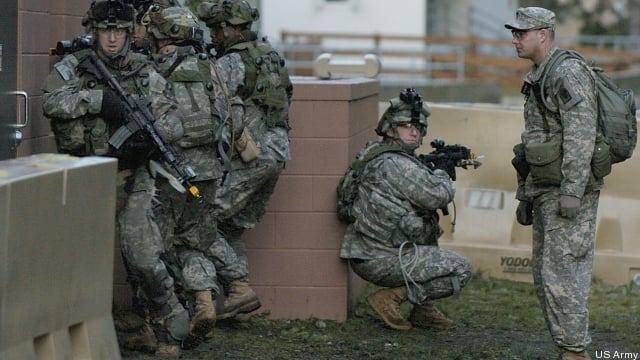Army Pushes New Training, Tech For Infantry Squads
Posted on

The Army has launched a major effort to strengthen its seven thousand infantry squads — an effort that will require overcoming cultural and bureaucratic resistance to succeed. Light-infantry traditionalists will have to get over their longstanding suspicion of digital technology both on the battlefield and in training, which will increasingly rely on simulations. Tech geeks will have to get past their reflex to throw a new gadget at every problem, because soldiers simply can’t carry any more gear than they already do. And everyone will have to get used to the idea that their funding might be taken away and given to someone with a better idea, with programs as different as weapons development and training courses potentially in competition.
When then-Chief of Staff Gen. Martin Dempsey — now Chairman of the Joint Chiefs — launched the initiative six months ago, “a lot of folks came in thinking it would be a lot of items to give the squad,” Maj. Gen. Robert Brown, commander of the Fort Benning Maneuver Center of Excellence, said during a panel at the annual Association of the US Army conference. “It’s much more than that. It’s the human dimension…. It’s materiel, leader development, and training, all on an equal footing.”
That approach includes the potential budgetary trade-offs across the three areas, Brown emphasized. To solve a tactical problem, the materiel development community might propose an upgrade to the M-4 carbine, but if adding more days of training or a new marksmanship simulator would solve the same problem more effectively — or, especially in these increasingly cost-conscious days, more affordably — the new approach would steer funding towards the training enhancements instead. Brown doesn’t expect to see significant shifts in the budgets now being put together, since there are too many variables still being figured out, but he predicts an impact on the POM (Program Objectives Memorandum) for 2014-2018.
The job Brown holds is itself a sign of how the Army’s changing: The “Maneuver Center of Excellence” he commands at Fort Benning is an amalgamation of the infantry “schoolhouse” that’s been at Benning since 1918 and what was the separate Armor Center, which moved down from Fort Knox on the orders of the 2005 Base Realignment and Closure (BRAC) Commission. The merger took years and was finally completed this summer. Tankers have long been comfortable with simulators, using technologies originally developed to train fighter pilots, but simulators for infantry combat are a new development and, for many, an uncomfortable one.
“I don’t think training has changed very much since I was an 11-Bravo [Army code for infantryman] in 1968,” said James Blake, the Army’s Program Executive Officer for Simulation, Training, and Instrumentation, who also spoke on the panel. But, he boasted, the Army has already fielded 839 “Engagement Skills Trainer” systems, a kind of virtual firing range where soldiers can train on various small arms both individually and in teams, including in counterinsurgency scenarios that test not only shooting accurately but knowing when not to shoot. Blake’s outfit is now working on a “dismounted soldier training system” that would effectively put virtual reality goggles on all nine members of a squad and put them inside the same scenario, interacting with virtual enemies and each other, so they can train for situations that their base might not have the facilities or the funding to simulate in physical reality.
At another presentation before the AUSA conference that same day, Col. Robert White, deputy commander for training at the Army’s Combined Arms Center, explained the new push for simulations in the cold light of the coming budget crunch. “We won’t have the same allocations of ammunition coming out of these conflicts as we had 11 years ago,” he said, offering just one example. A unit can no longer afford that one problem soldier who goes to the firing range and takes three days just to “zero” his M-4, White went on. Instead, that private will need to get it together on a virtual range beforehand, making mistakes without wasting ammo.
Not all the new training techniques are digital, however. Maj. Gen. Brown’s command sergeant major, a Ranger with 11 combat deployments named James Hardy, waxed enthusiastic at the panel about new skills training that dramatically increased soldiers’ performance on everything from the Army Physical Fitness Test to completing basic training to being able to tell when a foreign national is lying to them. In terms of manpower and equipment, “the squad has not changed that much over time – but what we expect the squad to do today has changed significantly,” Hardy said. Especially for young squad leaders, he went on, “there’s a lot of responsibility we heap upon their shoulders.”
Though the emphasis was on the human side rather than materiel, the new approach is not only about substituting better training for new equipment. In particular, panel member Brig. Gen. Camille Nichols promised that troops on foot will finally have access to the same digital communications networks that soldiers in tanks and Humvees have used since 2003. As the Army’s Program Executive Officer (PEO) Soldier, Nichols oversees the latest iteration of the decade-long Land Warrior program, now called Net Warrior. “We are in the throes of trying to get the production decision on that in the next 60 to 90 days,” she said, adding she expected “that program to actually get into the field in the next 12 months.”
New digital technologies are great, agreed CSM Hardy – as long as soldiers can still soldier on after they break down. “We want to ensure they’re network-enabled,” he said, “not network-dependent.”
Subscribe to our newsletter
Promotions, new products and sales. Directly to your inbox.
